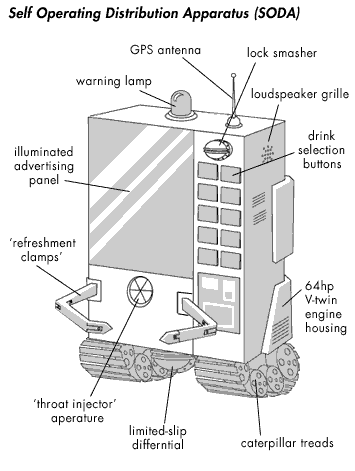 |
 |
|
|
 |
by Jason Torchinsky and Chris Boznos
|
| Today's ECTW report: The S.O.D.A. Project |
|
Carbonated sodas are a fundamental element of American life. If it were possible, would you be willing to give up an insignificant bit of your personal freedom to guarantee that would never be without a plentiful supply of sweet, delicious soda? PepsiCo is betting you would.
For the past 10 years, Pepsi engineers have been developing better ways to keep people connected with adequate supplies of refreshing soda. Previous successes in the field include the plastic bottle, vending machine that accept bills, the ‘wide-mouth’ can, and delicious Crystal Pepsi. But engineers feel that the public is thirsty for the next step: the Self-Operating Distribution Apparatus (SODA).
"In this year 2000, it is simply unacceptable for this country’s children to be deprived of colas, or any sort of soda for any length of time, " says Malcolm Borland, chief engineer of the SODA project. "I saw a family once, at the zoo. It was hot, and, though they bravely hid any outward sign of it, the children were in dire need of cold soda. The parents were helpless to heed their children’s unspoken cry. Although several soda vending machines were within sight, none was close enough. The children went sodaless, and I left with a burning resolve that no American family should ever have to go through such a nightmare again."
What Borland created in his labs over the next few months was a marvel of science, blending robotic and vending machine technology: a beverage dispenser that is not helplessly anchored to some fixed location, but capable of seeking you out to tend to your liquid whims. The premise is this: a customer purchases a pre-paid "ColaCard" at a wide variety of establishments, including Taco Bells, gas stations, Rite Aids, and most major metropolitan hospitals and hospices. This card entitles the purchaser to a custom-tailored amount of soda, based on a height/weight calculation. The cards, sold in $50 increments, are valid for one month and contain a SmartChip with an integrated GPS homing device.
The SmartChip keeps up to the minute information on how much soda the user has consumed, and sends GPS tracking data to the other part of the SODA project, the fully mobile soda vending machine.
|
 |
Looking much like a conventional soda machine mounted on caterpillar treads, an army of mobile Pepsi machines would be unleashed in most major cities, where they would tirelessly roam the streets, waiting to serve anyone’s soda wants. When a soda machine detects a thirsty user, either as signaled by the user via a button on the card, or as determined by the machine’s own ‘thirst-sensors’ (actually an algorithm based on the last time a soda was purchased) it enters "PPPP mode," or "Pepsi Patron Pursuit Protocol".
PPPP mode permits the machine to use any means necessary to provide the patron with their soda.
"We’re contractually obligated here," said Lionel Minkworth, Pepsi’s in-house legal counsel. "Those ColaCards are an agreement between us and our valued customers. When we sell that card to a customer, we have an obligation to fulfill that patron’s needs. And these machines are definitely up to the task."
Travelling at speeds up to 64mph, the agile and colorful machines can negotiate crowds, rocky terrain and even stairs to contact their customers. Machines in urban areas are even equipped with ‘lock-smashers’ to get through all but the most reinforced of doors. Once a machine has encountered and subdued its patron, the user is given a choice of how much soda they are willing to purchase at that moment, within the bounds of a $2 minimum and the machine’s current supply.
Usually, the soda is distributed in the conventional cans and plastic bottles. However, a special ‘throat injector’ may be employed in situations where a great deal of soda must be administered in a very short period of time, such as when a user needs to ‘finish off’ their pre-paid allotment as required by the contract. Using this method, a machine may administer as much as seven gallons of soda within a four-minute time frame. This procedure simply requires the patron to be held in the machine’s extendible ‘refreshment clamps’ while the injector tube is painlessly slid down the patron’s throat.
Here at VGG Extreme Cutting Edge Tech Watch, we applaud Pepsi’s bold new thirst-quenching approach. And, once the problems of injectors in the wrong orifice, rogue machines, and refrigeration are worked out, you’ll be sure to see these brave soldiers of the Cola Wars in your city!
|
|
 |
 |